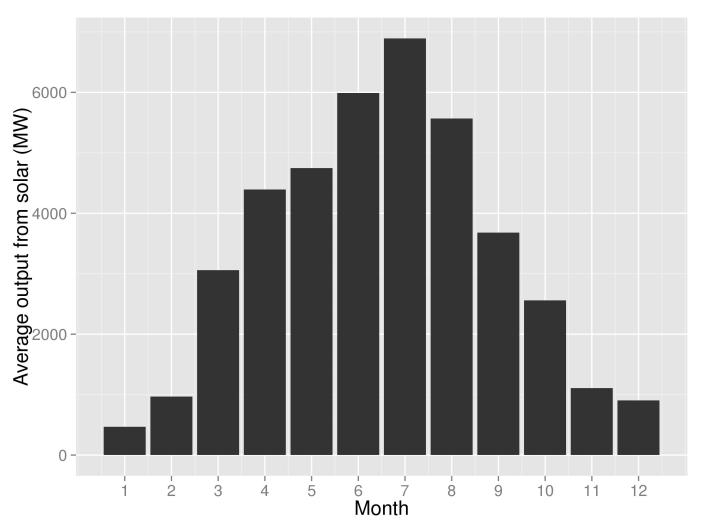Sorry Thomas Friedman, Germany will not become the world’s first solar powered superpower
From a recent piece by Thomas Friedman:
Here’s my prediction: Germany will be Europe’s first green, solar-powered superpower.
And here is a plot of the average power output from Germany’s solar panels in each month of 2014:
German solar output in January is less than one tenth of what it is in May, June, July or August. And winter, not summer, is when German electricity demand is at its highest.
These massive seasonal variations in solar power are matched by wild daily variations. Here is the average daily output in January and June. Does this look like a country which is about to become a solar powered superpower?
Furthermore, considerations of the extremes shows the implausibility of Germany running largely on solar power.
Germany’s average solar power output last year was 3376 MW. On the best day last year the average output was 8517 MW. On the worst day it was 81.5 MW. These peaks get the headlines. Strangely, we don’t see headlines on the day when German solar output was 1% of what it was on the record day.
So, unless Germany is tilted several degrees to the south, I can confidently predict that Thomas Friedman’s prediction is just the latest in a long line of absurd predictions about the future of energy.
Note on data
Code to produce the above plots (using R) and the data sources are given below.
require(gdata);require(ggplot2)
### German solar data available from http://www.pfbach.dk/
raw <- read.xls("2014_de_pv.xls", skip = 2)
names(raw) <- c("Date", "Hour", "PV")
de <- data.frame(Hour = raw$Hour, PV = raw$PV, Day = as.integer(substr(raw$Date,1,2)), Month = as.integer(substr(raw$Date, 4,5)))
#### Get the monthly average
mon.ave <- aggregate(de, by = list(de$Month), FUN = mean)[,3:5]
gg <- ggplot(data = mon.ave,aes(Month, PV))+
geom_bar(stat = "identity")+
xlab("Month")+
ylab("Average output from solar (MW)")+
theme(legend.position = "bottom", legend.title = element_blank())+
scale_x_continuous(breaks = seq(1,12))+
theme_grey(base_size = 16)
gg
### Daily average ##
day.ave <- aggregate(de, by = list(de$Month, de$Day), FUN = mean)[,3:6]
## Best, worst and mean output ##
meanOut <- mean(day.ave$PV)
maxOut <- max(day.ave$PV)
minOut <- min(day.ave$PV)
5 thoughts on “Sorry Thomas Friedman, Germany will not become the world’s first solar powered superpower”
Comments are closed.


May 13, 2015 at 12:36 pm
Dear Robert,
I guess you used 2013 data. 2014 data are aso available. http://www.ise.fraunhofer.de/de/downloads/pdf-files/data-nivc-/stromproduktion-aus-solar-und-windenergie-2014.pdf
Anyhow in my opinion it is better to report (average) production in p.e.GWh’s
regards, Math Geurts
LikeLike
May 13, 2015 at 12:42 pm
I said it was 2014 data in the post. What made you guess it was 2013?
And I don’t see how using GWh for average monthly production makes sense if you want to look at the seasonal cycle. Average GW numbers are also easily comparable with total capacity.
LikeLike
May 14, 2015 at 4:04 pm
Do you have any similar data for Australia?
LikeLike
May 15, 2015 at 7:36 pm
No
LikeLike
May 15, 2015 at 7:07 am
Have you noticed how German solar panel installations have collapsed as subsidies were trimmed back?
“New PV capacity installed in March 2015 amounted to 97.178 MWp, bringing PV capacity eligible for support under the Renewable Energy Sources Act (EEG) to a total of 38,555 MWp by the end of March, the regulator, Federal Network Agency (BNetzA), reported.”
http://www.germanenergyblog.de/?p=18533
At the current rate, German solar capacity will increase by less than 1.3 GW in 2015. Doubling of Germany’s solar capacity at this rate would take about 30 years.
LikeLike